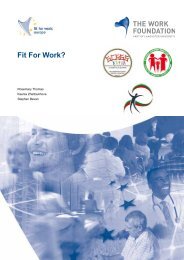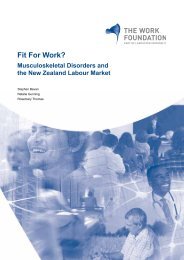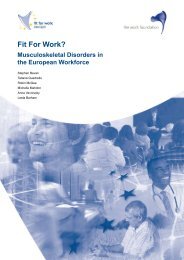English version - Fit for Work Europe
English version - Fit for Work Europe
English version - Fit for Work Europe
You also want an ePaper? Increase the reach of your titles
YUMPU automatically turns print PDFs into web optimized ePapers that Google loves.
MSDs and individuals<br />
74<br />
Figure 7.4. ICF model applied to work disability in RA<br />
(Impaired) body<br />
functions and<br />
structures<br />
Environmental<br />
factors<br />
Rheumatoid<br />
arthritis<br />
Activity<br />
(limitations)<br />
Personal<br />
factors<br />
Participation<br />
(restrictions);<br />
work (dis)ability<br />
Source: de Croon et al., (2004)<br />
Some critics of the biopsychosocial model have focused on this last point, highlighting concerns<br />
that this approach may encourage or ‘permit’ helplessness in some patients or that, in other<br />
circumstances, it may alienate patients who feel they are being told that their condition is ‘all in<br />
the mind’. Clearly, clinicians and others must take care in how they mitigate these risks, but the<br />
balance of the literature – and of the expert opinion offered during the course of our interviews –<br />
strongly supports the biopsychosocial model and its role in in<strong>for</strong>ming the management of MSDs<br />
in both clinical and occupational settings.<br />
An example of reducing sickness absence by using successful intervention based on the<br />
biopsychosocial model is provided by Ektor-Andersen, Ingvarsson, Kullendorff and Ørbæk<br />
(2008). In their study, Ektor-Andersen et al. (2008) developed a tool based on the CBT method<br />
of functional behaviour analysis, according to which risk factors <strong>for</strong> long-term sick leave due<br />
to musculoskeletal symptoms were identified in four different domains: the community, the<br />
workplace, the family/spare time and the health care system. Care-seekers were examined<br />
by each member of the interdisciplinary team and risk factors were identified and classified<br />
as stable or dynamic. Dynamic factors were the ones which the care-seekers and the team<br />
agreed to intervene on. Some of these interventions involved CBT or physiotherapy sessions,<br />
<strong>Fit</strong> For <strong>Work</strong>? Musculoskeletal Disorders and the Japanese Labour Market







